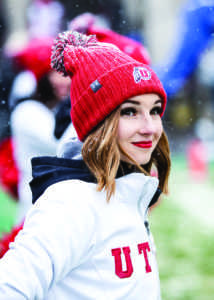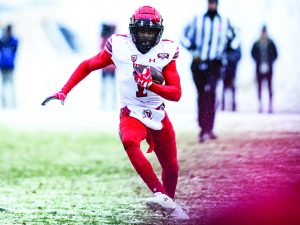Utah weather consists of all four seasons, from the heated 90-degree summers to the 10-degree winters. Of course, we can’t forget what Utah is best known for as well: the best snow on Earth.
Even though some of us are loving the cold, snowy winters and being able to go skiing at various ski resorts all winter long, there are some disadvantages that come from the snow as well. For example, the snow may cause there to be more accidents and traffic on the roads of Salt Lake City.
Snow and Sports
Just as the snow affects our everyday lives on the streets of Salt Lake City, it also affects the outdoor teams at the University of Utah as well. Teams like track and field, softball and baseball that aren’t suited to be played in the colder weather have learned to adapt to the snow and have learned to look at Utah’s weather as an advantage rather than a disadvantage.
As the U has grown into a more well-known school throughout the United States, there have been students coming to Utah from all around the nation and the world. Specifically, on some sports teams, students have had to learn how to practice their particular sport in new weather conditions.

(Photo by: Justin Prather | The Utah Chronicle).
“Well obviously there are seasons here in [Utah] which is something that I have never really experienced before, back in Arizona,” said 400-meter runner Jackie Martin, who hails from Chandler, Arizona. “Having to deal with a true fall, a true winter and spring and back home it’s 70 degrees all year long, except for the summer it’s about 120 degrees. But other than that I’d say that it’s been a really positive experience. I like running in colder weather and changing it up. For most of my life I have been in really warm climates, so being able to be in something that’s just different and new has been a really good experience.”
Utah has taken students like Martin who have learned to adapt to the weather changes in Utah. The Utes have also added members to the team from states that have similar weather patterns to Utah, who have not had any problems at all with the weather.
“For me, coming from Minnesota it has not been too bad,” distance runner Emma Christensen said. “Because at least for winters back home it gets super cold [as well], so this has not been too much of an adjustment. I actually feel more comfortable here and am still able to run outside most days. [I have noticed] that the snow melts a lot faster which I think is to our benefit so we can still get on paths to get our runs in.”
Colder Weather and Improved Performance
Even though the cold weather may have a conceived notion that it is more difficult to run in, according to “5 Reasons Why Running In the Cold Is Good for You” by Jessica Smith, experts have found that running in colder weather actually improves athletic performance and is better for one’s overall health. Smith says that the “cold is actually the ideal weather for running.”
“I really like practicing when it’s kind of getting colder,” Christensen said. “I’m not a really big fan of the heat. The later the track season gets the warmer it is outside, so that’s not my preference at all, but I don’t really mind the cold.”
Of course, there will be some days that may be difficult to continue practice outdoors. The Utes track team has found different ways that they are able to adapt to the snowy and rainy weather while still making their practices beneficial to the team.
“We have a training facility at the Olympic Oval in Kearns, Utah,” Martin said. “If it’s snowing or raining really bad normally we will head up there, or we will stay here on campus and do something like a bike workout, or we can do a pool workout. If the snow isn’t too bad then maybe we still go outside and just kind of modify [our practice], [for example], maybe not going as fast that day so no one has to worry about pulling a muscle. [The weather] definitely has an impact on our practices, but I feel like there are ways to work around it so it hasn’t really had a super negative impact.”
So far this season, the Utah track team has not needed to go up to the Olympic Oval to practice, but they have used that facility in the past during the rough snowy winter seasons. At the Olympic Oval, the Utes are able to do most of their regular routine which allows them to still have a worthwhile practice as a team.

(Photo by: Justin Prather | The Utah Chronicle).
The Utah Advantage
Some may say that practicing in Utah can be a disadvantage compared to the teams that are practicing in different states, but the Utah women’s track team believes that practicing in Utah can be more of an advantage for them compared to other schools. Competing against teams from different states, it is easy to think of the advantages and disadvantages each state has in their weather differences.
“I feel like a lot of states still have to deal with weather issues,” Martin said. “Like Washington or Oregon, all those states have to deal with snow as well. I think what kind of makes [Utah] an advantage is the fact that we are at elevation here, so training at an elevation and then going down to sea level at places like Seattle and Los Angeles kind of gives us an advantage during competition. Because now we are at sea level because now it’s a lot easier to breathe than it is here. But I mean it is harder I think because, unlike Arizona or unlike California schools, we can’t just practice outside every day. We do have to make modifications on certain days. At the end of the day though, I feel like we can work around it well enough.”
But Beware of the Air
The Utes have taken the weather changes throughout the year more as an advantage to the team rather than looking at it as a problem. Rather than the natural weather changes that occur all year, the one problem that has impacted sports teams in Utah the most has been the pollution and air quality which has an effect on the health of the players.
“I think the biggest thing, more than snow that affects us is air quality,” Martin said. “Like pollution, for example, today was a really bad day, so we were not allowed to practice outside due to health hazards, so today we did an indoor workout. I think that that probably has the biggest impact negatively on our training versus just normal weather, like when it’s snowing or when it’s super cold outside just because then you’re dealing with things where it’s harder for girls to breath and it’s more of health risk.”
Overall, the women’s track team has made the most out of adapting to the weather changes throughout the year. They have found that the hardest time for them to practice is not actually coming from really snowy or rainy days, but it is actually more difficult to practice in times where the air quality is really bad. They have learned to find ways to make the most out of the weather and don’t allow for it to become a disadvantage for their team.



